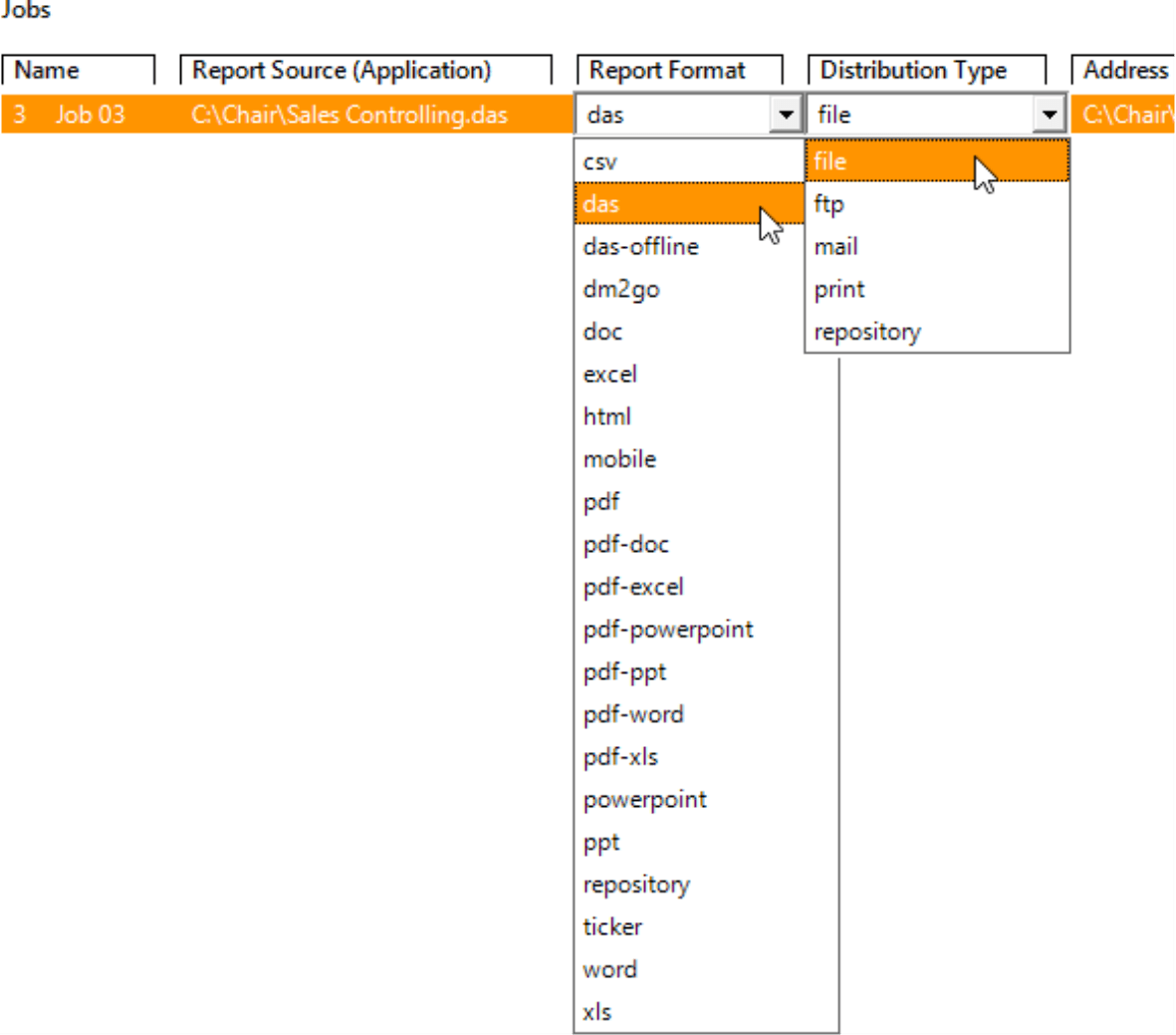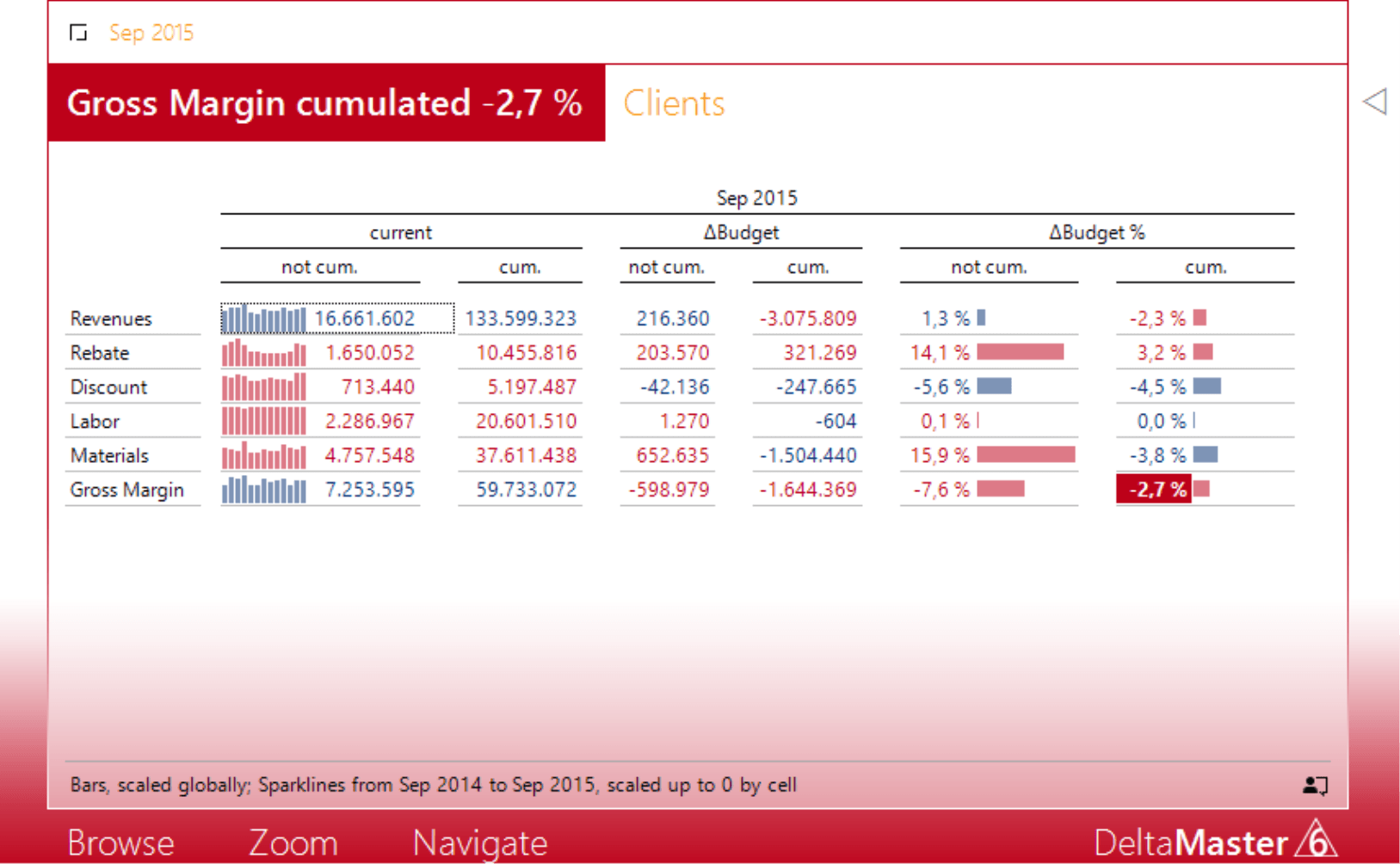Greetings, fellow data analysts!
Distributing reports is the one task in Business Intelligence where you can see the efficiency gains so clearly like nowhere else. Once you have created a DeltaMaster application or analysis session, you can use it as a template to automatically generate, update, assemble, and distribute tailored briefing books for individual consumers – all at marginal cost close to zero. In order to do that, you need a report format called Graphical Tables, which ensure efficient, reliable production processes with no follow-up work. Another advantage of Graphical Tables is that they are easy to read and clear to understand – which you surely know because we have frequently discussed that already. This time, we will focus on the output of automated reporting. For publishing reports (using the ReportServer as the module is called in DeltaMaster 5) DeltaMaster offers a wide range of output formats and channels. We will provide an overview of these options as well as tips regarding selection in a three-part series of DeltaMaster clicks!. Part 3 offers a few closing thoughts for selecting the report format and distribution type.
Best regards,
Your Bissantz & Company team
When you publish reports (or work in ReportServer), you can define the Report Format and Distribution Type for each individual job. This opens a world of opportunities for automated reporting. We will explore some clever ways to use them in this edition of clicks!.
For that, we assume a widespread structure: The Data Warehouse and the reports, which build on it, are maintained centrally. The reports are to be distributed to many different recipients, for example, branch managers, outside sales representatives, cost center managers, product managers, executives, or external partners.
A brief list of requirements
When considering how to design your automated reporting, start by reviewing these five aspects – even if they are not 100% complete – as food for thought.
- Currency of the data: Should report data be pulled dynamically from the database or would static reports suffice?
- Analytic capabilities: Should recipients be able to analyze the data on their own? If so, should these capabilities be sophisticated or basic (e.g. filtering)?
- Usage environment: Where do the recipients use their reports? How often do they use them? Which software and hardware do they use?
- Further processing: Are the report recipients “end consumers” or do they need to add comments or incorporate the content into other documents?
- Security: Do you need capabilities to manage access to the reports and the data they contain at any time?
Currency of the data
The DeltaMaster-specific report formats “das” and “repository” are dynamic. When you publish, these reports will be recalculated when they are displayed – either automatically (e.g. upon changing a view) or when the user updates them (with the F9 key or the respective menu commands). In other words, the data in the report is as current as it can be (i.e. in the database). In the Repository, this applies to both the report data and DeltaMaster application. When an application has been updated, it is immediately available in the updated version – and only in this version. The previous version no longer exists, unlike files where copies may still exist. Another advantage of storing applications in the Repository is that you can use them with DeltaMaster in so many ways, including the Windows client, WebClient, the App for iPhone/iPad, and the Office add-in.
All other report formats (e.g. Office formats, PDF, HTML) are static. They display the values that were available when the file was generated. That suffices (and is sometimes explicitly requested) for many use cases, for example, when the data does not change frequently as in the case of monthly or quarterly reports. Other reasons for using a static format may have to do with the usage environment of the recipient (see below), processing load of the database server, or licensing model of the database vendor.
As a side note, you can also use static versions of DeltaMaster-specific output files. Using the “das-offline” and “mobile” formats, you generate reports for DeltaMaster or DeltaMaster ReaderApp that require no connection to the database. In addition, you can also open a normal DAS file (i.e. a saved analysis session) without a database connection because the values displayed in the reports are saved to the file. DeltaMaster only needs to run a new query on the database when you recalculate the reports (e.g. by hitting the “F9” key or changing the view).
Analytic capabilities
When the recipients should or want to analyze their data own their own, the DeltaMaster formats are the best choice hands down.
Here it makes no difference, how sophisticated the analytic requirements are. Many users are completely satisfied when they can change a few filters to switch the view to a different country, product color, or from the current to the previous month.
Browse, Zoom, and Navigate, the core analytic functions of DeltaMaster 6, are especially easy to use and very powerful as well. With these three functions, users can answer most of the questions that arise in a report – immediately and without leaving that report. The Zoom and Navigate features are even supported in a Web browser or on iPhone/iPad devices. Links enable a direct jump into the analytic methods of DeltaMaster, up to Data Mining. To offer users such interactive analyses, select “das”, “dm2go”, or “repository” as the report format. The “repository” format is required to use the report in WebClient and in the app for iPhone/iPad.
DeltaMaster generally needs to query the database to conduct interactive analyses. The “das” and “repository” formats are dynamic as defined in the previous section. They can connect to the database and pull current data from it. The “dm2go” format is an exception because it accesses data from a database extract that was included in the file. Users can conduct interactive analyses based on this static data (see DeltaMaster clicks! 07/2013).
Usage environment
Let’s quickly recap what we have already discussed: There are many good reasons to solely rely on DeltaMaster to automatically distribute reports. Nevertheless, not every recipient can use DeltaMaster anywhere and all the time. Many users probably only have Microsoft Office, Adobe Reader, and similar programs – if at all, in the case of smartphones. DeltaMaster supports these scenarios as well with universal formats: PDF, Word, Excel, PowerPoint, and HTML. PDF files, in particular, are relatively robust and are reasonably supported even on lesser common devices and operational systems used in companies. The results are all static. When there is new data, new files will need to be generated.
The distribution type also depends on the usage scenario and conditions. Employees who primarily work in the office or in the field with a good (VPN) connection to the enterprise network can work well with files on the file server. In these cases, the repository would offer a good alternative as well. Emails are sure to grab your readers’ attention when you make the effort to use strong subject lines (see DeltaMaster clicks! 06/2013). On the other hand, emails have something transient about them. Keeping things in order also requires a certain amount of discipline from the recipients.
Processing
Many times, a report has fulfilled its purpose when the recipient knows what to do, who to contact, where adjustments are necessary, and what is missing – true to our slogan “Look, see, do”. Other times, the report is just a part of something greater and the recipients need to add comments, justify forecasts, give recommendations, substantiate arguments, and possibly add a report from another source. If no further processing or changes to the documents are desired, PDF files are a good option. An HTML mail is more flexible. When forwarding emails, for example, recipients can add comments between the reports, change the headings, or delete reports that are not required. Exports as Word documents or PowerPoint presentations are especially suited for further processing. These formats are also robust enough for creating extensive documents.
In the case of complex word processing requirements, for example, that require pages of argumentation aside from the DeltaMaster reports, you should consider using DeltaMaster Add-in for Microsoft Office. Instead of exporting the DeltaMaster reports (i.e. “push” as by publishing), this add-in embeds them as dynamic objects in Word documents or PowerPoint presentations so that they can be immediately updated in Word or PowerPoint (i.e. “pull”). You can also use this option to present various data sources in one document. For more information about the Add-in, please read DeltaMaster clicks! 12/2013.
The DeltaMaster-specific formats are also well suited as the starting point for further processing. You can add comments, even on individual values (cell comments, see DeltaMaster clicks! 10/2015) and copy reports to the clipboard to transfer them to other documents.
Security
The DeltaMaster formats “das” and “repository” are very strong when it comes to security. You can change the access rights for applications, folders, and reports at any time in the Repository, for example, to recall or deny access to reports. DeltaMaster offers its own, comfortable interface for administrating permissions, oftentimes, within the departments themselves. Beyond these permissions, those in the database are and remain valid even when the users access the database through analysis sessions (DAS files) or other programs and not through the Repository. Changes to the database permissions, or course, are possible as well. These, however, require the tools and methods of the respective database products, which is usually a task reserved for IT professionals.
Office and PDF files are difficult to withdraw or eliminate by nature. Nevertheless, you can at least protect the document from unsolicited access by encrypting them and adding a password (see DeltaMaster deltas! 5.5.5, feature #3.) The once common complaint that hacking encrypted Office documents is child’s play no longer holds true provided that you use the file formats introduced in the 2007 version (i.e. DOCX, XLSX, PPTX) as described in the aforementioned deltas!.
Summary
Let’s just review what we have already covered. Generally speaking, there are many strong arguments – for editors, administrators, and recipients to exclusively use DeltaMaster! The Repository, in particular, paves the way for intelligent solutions, both big and small. There are also logical reasons to offer other formats, such as PDF files, or send reports directly as an HTML mail. The good news is that DeltaMaster supports all of these options so you can use them alone or combine them as you need for your tasks. This also holds true for scenarios that we could not describe here – for example, applications that are only accessible through Repository (without Publish/ReportServer) or are integrated in portals such as SharePoint. If you have any questions or need support in planning your automated reporting processes, please contact your Bissantz & Company team.


